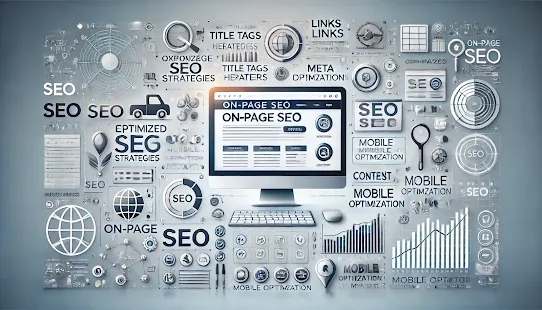In the fast-paced world of digital marketing, on-page SEO is a fundamental aspect of ensuring your website ranks higher in search engine results. While many focus on off-page SEO tactics such as backlinks, on-page SEO should never be overlooked. This guide will walk you through the essential strategies and best practices to enhance your website’s visibility and performance.
What is On-Page SEO?
On-page SEO refers to the strategies and techniques used directly on your website to improve its search engine ranking. This includes optimizing elements such as title tags, meta descriptions, headers, URLs, content, and images. By carefully implementing these on-page SEO practices, you can increase your chances of ranking higher in Google’s search results, which ultimately leads to more organic traffic.
Key Elements of On-Page SEO
1. Title Tags
Your title tag is one of the first things search engines and users see when your page appears in search results. A well-crafted title tag is crucial for improving click-through rates (CTR) and overall rankings. Ensure that each title tag includes your target keyword and accurately reflects the content on the page.
Tip: Keep your title tag under 60 characters to avoid truncation in search results.
2. Meta Descriptions
Meta descriptions provide a brief summary of your page content and can directly influence your click-through rates. Although meta descriptions do not directly impact search rankings, a well-written meta description can encourage users to click on your link over others.
Tip: Include a compelling call-to-action and relevant keywords, while keeping the description under 160 characters.
3. Header Tags (H1, H2, H3, etc.)
Header tags organize your content into a structured hierarchy. The H1 tag should include your primary keyword and clearly describe the main topic of the page. Using H2 and H3 tags helps break your content into digestible sections, improving readability and SEO.
Tip: Use header tags to improve content organization and make it easier for both search engines and users to understand.
4. Optimized URLs
URLs play an important role in on-page SEO. A clean, descriptive URL that includes relevant keywords can help search engines understand the content of the page and improve your rankings.
Tip: Keep your URLs short, descriptive, and easy to read. Use hyphens to separate words.
5. Keyword Optimization
Strategic keyword usage throughout your content is key to improving your search engine rankings. Incorporate your target keywords naturally into the content, titles, headers, and meta descriptions. Avoid keyword stuffing, as search engines may penalize your page for over-optimization.
Tip: Use related keywords and synonyms to avoid repetitive phrasing and improve content readability.
6. High-Quality Content
Content is the backbone of your on-page SEO strategy. Ensure your content is engaging, informative, and valuable to your audience. Search engines prioritize content that answers users' queries, so focus on delivering high-quality, original content that aligns with user intent.
Tip: Regularly update your content to keep it fresh and relevant.
7. Internal Linking
Internal links help guide users through your website while also assisting search engines in understanding the structure and relationship between your pages. Use descriptive anchor text to link to related pages within your site.
Tip: Avoid overloading your content with too many internal links. Keep it natural and relevant.
8. Image Optimization
Images are an essential part of user experience, but they can also affect your on-page SEO. Ensure your images are optimized for both performance (speed) and search engines. Use descriptive filenames, alt text, and compress images to reduce page load time.
Tip: Include keywords in your image alt tags, as search engines can index them and improve image search rankings.
9. Mobile-Friendly Design
With the majority of searches now taking place on mobile devices, having a responsive and mobile-friendly website is crucial for both user experience and SEO. Google uses mobile-first indexing, meaning it predominantly uses the mobile version of a site to determine rankings.
Tip: Test your website on multiple devices to ensure it is fully optimized for mobile users.
Conclusion
Effective on-page SEO is a long-term investment that pays off by driving organic traffic, improving user experience, and increasing your website's authority. By focusing on the key elements of on-page SEO, you can improve your site’s performance and climb the search engine rankings. Keep optimizing, stay updated with algorithm changes, and consistently produce high-quality content to achieve the best results.




0 Comments